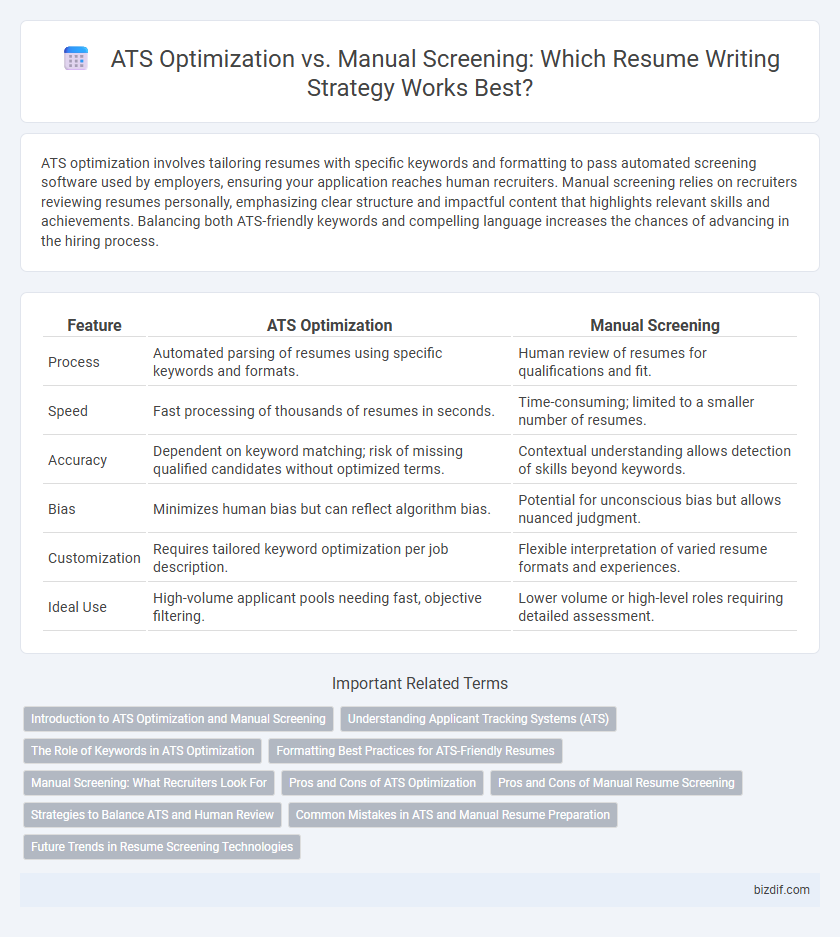ATS optimization involves tailoring resumes with specific keywords and formatting to pass automated screening software used by employers, ensuring your application reaches human recruiters. Manual screening relies on recruiters reviewing resumes personally, emphasizing clear structure and impactful content that highlights relevant skills and achievements. Balancing both ATS-friendly keywords and compelling language increases the chances of advancing in the hiring process.
Table of Comparison
| Feature | ATS Optimization | Manual Screening |
|---|---|---|
| Process | Automated parsing of resumes using specific keywords and formats. | Human review of resumes for qualifications and fit. |
| Speed | Fast processing of thousands of resumes in seconds. | Time-consuming; limited to a smaller number of resumes. |
| Accuracy | Dependent on keyword matching; risk of missing qualified candidates without optimized terms. | Contextual understanding allows detection of skills beyond keywords. |
| Bias | Minimizes human bias but can reflect algorithm bias. | Potential for unconscious bias but allows nuanced judgment. |
| Customization | Requires tailored keyword optimization per job description. | Flexible interpretation of varied resume formats and experiences. |
| Ideal Use | High-volume applicant pools needing fast, objective filtering. | Lower volume or high-level roles requiring detailed assessment. |
Introduction to ATS Optimization and Manual Screening
Applicant Tracking Systems (ATS) scan resumes using keyword matching, formatting, and relevance algorithms to streamline candidate shortlisting, whereas manual screening relies on human recruiters evaluating qualifications and experience. ATS optimization involves tailoring resumes with specific keywords, clear structure, and standardized headings to pass automated filters effectively. Understanding the differences between ATS and manual screening helps job seekers balance keyword optimization with readability for human reviewers.
Understanding Applicant Tracking Systems (ATS)
Applicant Tracking Systems (ATS) are software tools used by employers to streamline the recruitment process by automatically scanning and ranking resumes based on keyword relevance, format, and structure. Optimizing resumes for ATS involves incorporating specific industry keywords, clear headings, and simple formatting to ensure compatibility and increase the chances of passing the initial screening. Understanding how ATS algorithms prioritize information helps candidates tailor their resumes to meet automated criteria, improving visibility and selection rates in competitive job markets.
The Role of Keywords in ATS Optimization
Keywords play a critical role in ATS optimization by ensuring that resumes are accurately parsed and ranked according to the job description. ATS systems scan for specific terms related to skills, experience, and qualifications, making the strategic inclusion of relevant keywords essential for passing automated screening. Effective keyword use bridges the gap between ATS algorithms and manual screening by increasing the likelihood of a resume reaching human recruiters.
Formatting Best Practices for ATS-Friendly Resumes
Utilizing simple, clean formatting with standard fonts and clear headings enhances ATS optimization by ensuring resume parsing accuracy. Avoiding complex layouts, tables, and graphics prevents data loss during automatic screening processes, increasing the likelihood of passing initial ATS filters. Incorporating relevant keywords naturally within section headers and bullet points supports both ATS recognition and manual recruiter readability.
Manual Screening: What Recruiters Look For
Recruiters prioritize clarity, relevance, and impactful achievements when manually screening resumes, focusing on tailored keywords and quantifiable results that demonstrate candidate fit. They look for concise formatting that highlights core competencies, professional experience, and education aligned with the job description. Emphasis is placed on unique skills and career progression that differentiate candidates beyond automated ATS keyword matching.
Pros and Cons of ATS Optimization
ATS optimization enhances resume visibility by efficiently parsing keywords and formatting, increasing the likelihood of passing initial screenings. However, over-optimization may lead to keyword stuffing, reducing readability for human recruiters and potentially missing nuanced qualifications. Balancing ATS-friendly formatting with clear, concise content ensures better screening outcomes in automated and manual review processes.
Pros and Cons of Manual Resume Screening
Manual resume screening allows recruiters to evaluate candidates' qualifications, experience, and cultural fit with greater nuance and context than automated systems, enabling personalized assessments. However, it is time-consuming and prone to human biases, which can lead to inconsistent evaluations and overlook qualified applicants. Despite its limitations, manual screening remains valuable for roles requiring subjective judgment and complex skill assessments.
Strategies to Balance ATS and Human Review
Effective resume writing requires a strategic balance between ATS optimization and manual screening by incorporating relevant keywords that match job descriptions while maintaining clear, concise language for human readers. Using standard formatting, bullet points, and avoiding complex graphics ensures ATS compatibility without sacrificing readability. Emphasizing quantifiable achievements and tailored content increases the likelihood of passing both automated scans and engaging hiring managers.
Common Mistakes in ATS and Manual Resume Preparation
Common mistakes in ATS optimization include keyword stuffing, improper formatting, and neglecting to use standard fonts or headings, which can cause resumes to be rejected by automated systems. Manual screening errors often arise from overlooking detailed achievements, inconsistent formatting, and excessive jargon that hinder readability. Understanding the distinct requirements of both ATS and human reviewers ensures resumes pass automated filters while engaging hiring managers effectively.
Future Trends in Resume Screening Technologies
Future trends in resume screening technologies emphasize the integration of artificial intelligence and machine learning to enhance ATS optimization, enabling systems to better understand context and semantic relevance beyond keyword matching. Manual screening is gradually augmented by AI-driven tools that provide predictive analytics and candidate scoring, improving accuracy and efficiency in identifying top talent. Advances in natural language processing will further refine automated reviews, making resume evaluations more aligned with human recruiter preferences and reducing bias.
ATS Optimization vs Manual Screening Infographic

 bizdif.com
bizdif.com